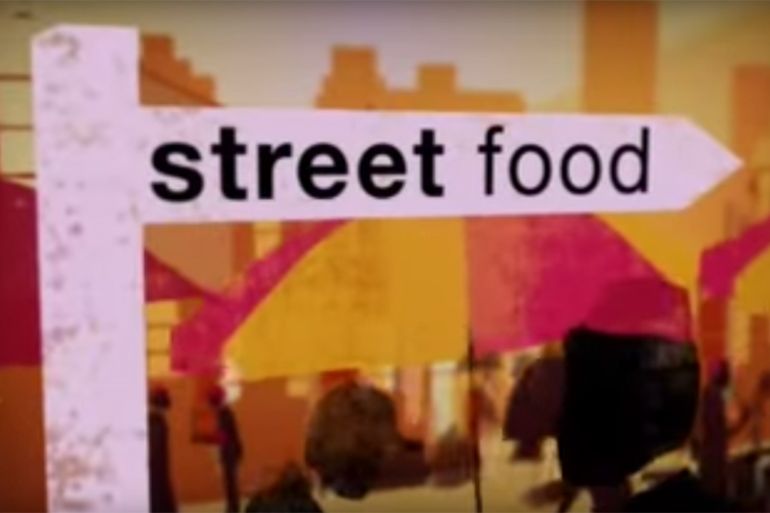
Street Food
Get ready to dine on local culture in an exciting and revealing new travel show.

Street Food – the very essence of a country or region’s tradition. Wherever you go in the world, the food of the streets mirrors the ways of ordinary people – each recipe reflecting lifestyle, race and religion.
Often developed over centuries, it is more than a cheap source of nourishment. It tells stories of shifting populations, trade connections and evolving identities. Key ingredients proclaim a melting pot of cultures, while culinary customs and techniques give a place its individuality.
Often across the world – from the richest city to the poorest backwater – the story of street food is one of poverty, struggle and enterprise.
Some dishes are iconic, others unknown beyond their street corner, but all blend the flavours of local history, economy and politics. And they are given extra piquancy by very relevant modern issues – famine, obesity, ethnic rivalry, the environment.
Whether you are a tourist or a local tribesman, join us on a unique global exploration of street fare.
| Nairobi |
One of the most interesting things about Nairobi is its diversity. There are more than 42 different ethnic communities living in the Kenyan capital. Each brings unique dishes, traditional foods and flavours.
However, as with all African cities, the divide between rich and poor is very stark.
Many millions of people across Africa are dependent on street food not only for nourishment, but as a means of making a living.
But poor hygiene practices and rising food prices cost thousands of lives.
Street Food explores what, if anything, is being done to tackle the issue.
| London |
Visitors to London could be forgiven for thinking they are seeing a quintessentially English city.
But behind the picture postcard facade of some of its most recognisable monuments, London is one of the most multicultural capitals in the world.
More than a third of Londoners belong to a minority ethnic group and speak one of the 200 different languages in the city of about eight million people.
Nowhere is this more evident than in the city’s East End, an area that has seen centuries of immigration.
Food has played a crucial part in the integration of these communities and one street – Brick Lane – above all, tells this story.
Once the home of traditional fare, it is now the heartland of the city’s Bangladeshi community.
| New York |
Known as the Big Apple, New York City is home to about nine million people and hosts an additional 40 million visitors every year, which makes for a lot of stomachs to feed.
Quick snacks, above all the hot dog, are as synonymous with New York as yellow cabs and skyscrapers and reflect the city’s eclectic ethnic mix.
Yet few people realise that many of the city’s thousands of street vendors – including Brooklyn’s famed ‘Falafel King’ – face a daily struggle that belies the city’s wealthy and glamourous image.
| San Sebastian |
San Sebastian is the food heartland of Spain’s Basque region.
The Basque people are proud and protective of their culture, language, and traditions. Among the traditions they have maintained are the men-only food societies, where women are barred from cooking and the conversation over a meal ultimately turns to the sometimes volatile political climate.
The cuisine, both in Basque homes and on the streets of San Sebastian, is also a product of a traditional way of life – seafood, delivered by generations of local fishermen – takes centre stage.
This fish diet, around which the Basque palette revolves, is one these people want to preserve. It provides local families with a livelihood and their evening meal, but over-fishing and competition threaten stocks and a unique way of life.
From the alleys of San Sebastian dotted with pinxto bars, to nearby sleepy fishing villages where fish is consumed directly from the sea – this episode of Street Food explores the struggle to preserve identity and to maintain simple local traditions.
| Penang |
Whether you are a tourist or a local tribesman, Veronica Pedrosa discovers the street really is the place to eat.
But the food does more than feed locals and visitors alike, it tells a story that has developed over time – influenced by the movement of people, the trade of produce and the demands of consumerism – it caters not only to the tastebuds but the hip pocket, where meals are fast and often inexpensive.
It is through this food that we are given a window into the lives of ordinary people – the people that give a place its soul and identity.
This Malaysian state epitomises the variety, colour and flair of Asian street food culture. We discover a land where multiculturalism is not an aim but very much a long-standing way of life.
| Beijing |
China’s economy is expanding at an astounding rate – but its waistlines, are too.
The food of the streets tells the story of a culture torn between tradition and modernity, the customs of an ancient past competing with the convenience age of the new.
What will survive and what will be lost? In a China which has gone within two generations from mass starvation to mass obesity, what does the future hold?
| Cairo |
A desperate shortage of staple foods, brought about partly by oil prices, has sparked riots around the world. In Egypt, where the common word for bread means “life”, Street Food investigates the cost for the average person.
| Jerusalem |
A city torn by politics and war – yet whatever a citizens’ race and religion, much of their customary street food is the same. What does it say about a shared identity and, despite decades of turmoil, how much does that bring hope for the future?
This series first aired in 2008.